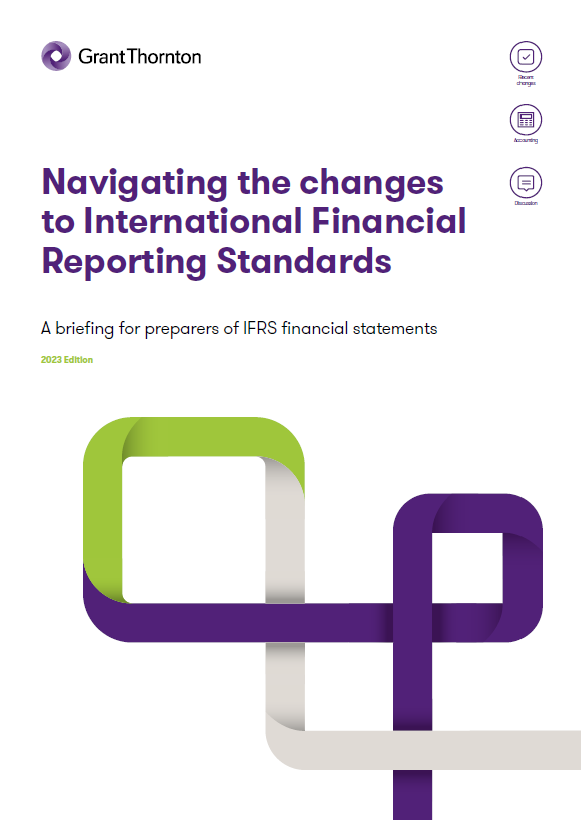-
Audit methodology
At Grant Thornton, we use a single audit methodology across our global network. This means that our clients gain the same proven, high-quality approach wherever they are.

-
Financial statements and consolidated financial statements
Preparation of monthly, quarterly or annual report and consolidated report on the basis of information presented by the client.
-
Financial Accounting
Effective bookkeeping and financial accounting are essential to the success of forward-thinking organisations. To get the optimum benefit from this part of your business, you'll need an experienced team behind you.
-
Tax compliance
Tax is likely to have an impact on almost every business decision you make. Whatever your business’s specific needs, we respond quickly and devise solutions tailored to you. We perform VAT, income tax, social tax and other tax accounting as well as present tax declarations to the tax authorities.
-
Chief financial officer service
Chief Financial Officer services include the periodic reporting, information systems standardization, internal document management and information flow optimization, budget preparation, cost accounting, cash flow and working capital management, financial analysis, investment return evaluation for managers.

-
International taxation
Grant Thornton operations in the Baltic States give us an access to the international expertise and allow advising the client on the minimisation of tax risks arising from conducting business in a foreign tax jurisdiction. We also consult foreign investors in finding an optimum group structure and form of enterprises in Lithuania and other Baltic States.
-
Transfer pricing
We advise the management bodies of local and multinational groups of companies in issues concerning transfer pricing of intra-group transactions and, if necessary, in the preparation of the relevant compliance documents. We also assist in preparing transfer pricing policies in order that future transactions are priced in accordance with the local as well as international regulations.
-
VAT refunds
We advise foreign clients in issues concerning the refund of value added tax paid in Lithuania, and Lithuanian clients – in the refund of value added tax paid in the EU member states. If necessary, we carry out these procedures on behalf of the client.
-
Profit tax, tax incentives
Our tax advisory department consults local and international clients in both everyday and specific taxation issues related to business activities.
-
Due diligence
Making the right investment decision can have a significant impact on shareholder value. To make an informed investment decision and create the best value from the transaction you will need the following an understanding of the target business identification and understanding of key business drivers an understanding of all the relevant issues clear analysis, conclusions and recommendations.
-
Assistance and representation during tax investigations, inspections, disputes
We provide services for registration in the Register of Taxpayers and the Register of VAT Payers. We represent clients' interests in tax disputes at the State Tax Inspectorate, Tax Disputes Commission, courts and other institutions.

-
Legal advisory for business start
We assist to quickly establish a company, branch or permanent establishment in Lithuania, open a bank account, VAT registration and obtain all necessary licenses for activity.
-
Legal advisory for business development
Our team has gained the greatest experience in advising international companies on the management of groups of companies. We advise and implement reorganizations or liquidations. Together with a team of tax and financial advisors, we perform a comprehensive due diligence (tax, legal & financial).
-
Labor law for CEOs and employees
We provide modern labor law solutions for the CEO, C-level managers and employees, which are tailored specifically to your business industry. We will take care of well-judged employment contracts and benefits package, protection of confidential information and non-compete agreements, handling of employee data or stock option rules, posting of employees, employment of EU and third-country nationals, organization of telework.
-
Fintech
With extensive experience in money laundering prevention and compliance and a strong team of financial experts, we advise clients on financial services, electronic money, licensing of payment institutions, capital formation, listing of mutual lending platform operators and other operational issues.
-
Migration and relocation
We assist you, your family members and employees of the organization to obtain national and European Union (Schengen) visas, residence permits, e-resident status, provide mediation letters and ensure a smooth relocation to Lithuania.
-
Due diligence
Making the right investment decision can have a significant impact on shareholder value. To make an informed investment decision and create the best value from the transaction you will need the following an understanding of the target business identification and understanding of key business drivers an understanding of all the relevant issues clear analysis, conclusions and recommendations.
-
Fintech advisory
The rapidly changing world and evolving technology are driving the development of new business models such as acting as a payment institution, a provider of virtual currency services and a financial institution. Grant Thornton Baltic provides support and advice to these companies.
-
Corporate finance management
Building a successful business requires a clear vision backed by a focused strategy. To achieve this vision, businesses must negotiate an increasingly complex environment.
-
Business Valuations
Choosing the right valuation method is the most important element in the process of estimating the fair value of a business as it must be adequate in terms of the purpose and object of the valuation. Grant Thornton uses only proven and generally accepted methods from among the wide range of income, asset and market approaches. Having conducted a preliminary analysis of the object and purpose of the valuation, we identify the method that will be the most appropriate considering the situation and characteristics of a given enterprise and the business sector in which it operates. Prior to commencing valuation, we also identify the documents necessary in the process.
-
Mergers and acquisitions
We provide advice to clients in all material aspects of the process of conducting transactions: finding a candidate for buyer, purchase or merger, initial analysis and valuation, negotiations, due diligence, structuring transaction price, preparing legal documentation and formal closing of the transaction. We also provide consultation for management buyouts.
-
Protection of Interests of Bondholders'
Grant Thornton provides bondholders' advocacy and protection services. We have resources, knowledge and the latest technology. Defending the interests of bondholders · Representing the interests of bondholders
-
External Financial Management Services
Providing an external financial management services makes it possible to manage a company’s finance on a day-to-day basis by a competent economist, without the need of offering full-time employment. By cooperating with experts on managing big-budget projects, we provide our clients with excellent support in comprehensive management of company’s finance.
-
Training
Financial Management Training and Seminars. Our experts have significant regional competence and close co-operation with our global colleagues. They happily share their expertise with our clients.

-
Internal Audit Services for Financial Sector Companies Licensed in Lithuania
Internal audit services adapted to Lithuanian financial sector companies ensure compliance with regulatory acts, risk management and operational excellence.
-
Internal Audit Services for EU/Foreign Aid Projects
Internal audit for EU/foreign aid fund projects helps to ensure compliance of activities and related costs with requirements.
-
Internal Audit for the Companies Certified by ISO
Internal auditing ensures ISO standard compliance, evaluates management system effectiveness, and gathers objective evidence of performance.
But firstly, can there be no interest rate at all? In transfer pricing, the notion of an interest-free loan was always perceived as precarious with most entities avoiding such risk-prone models, as for 99,99% of cases such interest-free loans would most likely fall. This comes from the long lived notion that no loan must go without interest as interest free loan arrangements usually do not occur between independent parties. In real life group relations, interest free loans can be justified under certain legitimate business reasons but historically a significant portion of such cases were challenged by tax authorities demanding that the unpaid interest to be treated as deemed revenue.
One such example was a famous Statoil case whereas Statoil ASA, a Norwegian company, granted an interest-free loan to its wholly owned subsidiary Statoil Angola. Statoil Angola had previously received interest-bearing loans from Statoil SCC (a Belgian company with no ownership interests in Statoil Angola) which fully exploited Statoil SCC 's borrowing capacity, therefore, Statoil ASA did not calculate interest on their loan granted after, as the loan capacitance was already exceeded. Norwegian tax authorities reasoned that Statoil Angola’s borrowing capacity should have been split between the two loans and insisted that interest revenue should be deemed on Statoil ASA’s part of the loan. Statoil ASA appealed the allegations by stating that Statoil Angola did not have the financial capacity to carry larger interest-bearing loans than the loans taken out from Statoil SCC which means that it would not have been possible for Statoil Angola to obtain the loan from an independent lender. In such case, the interest-free loan is not a result of the partnership between Statoil ASA and Statoil Angola, but it is commercially justified as Statoil ASA’s choice to operate Statoil Angola with low equity and use capital grants in the form of interest-free loans provide greater flexibility regarding repayment as opposed to riskier return on capital investment. In the end, The Supreme Court concluded the case agreeing that Statoil’s allocation of the full borrowing capacity of Statoil Angola to the loan from the sister company in Belgium was based on commercial reasoning and is compliant with the arm’s length principle. The Court discerned that Statoil Norway – unlike Statoil Belgium – had a 100% ownership of Statoil Angola, and the lack of interest income would therefore be compensated through the benefit of an increased value of its equity holding in Statoil Angola.
Beyond interest free loans there are numerous other intragroup financing transaction pricing nuances, that cause disagreements during tax audits and later in courts. Recent German Federal Fiscal Court rulings gathered exceptional attention as one after another three rulings presenting quite differing outcomes were released. On the first one the Court released a ruling that concluded that the fact of an unsecured loan being subordinated does not by itself contradict charging a risk premium on interest. This was widely received as a more economic logic based view of risk compensation that is taken by most taxpayers and is now strengthened by this new ruling. The new ruling was a contrast to the former Finance Court of Cologne decision which stated that difference in interest premium between a senior secured and junior unsecured loan was deemed a hidden profit distribution. The last of the three rulings strengthened the position that other corporate debt instruments (e.g., alternative revenue from fixed deposits or cost of market rate bonds) can be used as arm’s length comparables to price intercompany loans. Moreover, this ruling come to an understanding that the fact of unrelated lenders granting unsecured loans to a parent company is not a sufficient argument to state that granting of an unsecured intercompany loan to a subsidiary is a completely incomparable case, i. e. the absence of only one condition from a comparable transaction should not by default mean that the intercompany loan is not at arm’s length.
More localised transfer pricing practice in terms of the Baltics is very scarce, so it is very likely that in case of court proceedings, local Courts would “take a look” at foreign Courts practices. This means that such historical foreign rulings can be used as an indicator of what to expect when implementing policies and partaking in risk-prone intercompany engagements. If business operations lead to high-risk intercompany financing engagements, it is always highly recommended prior to concluding such transactions to consult with specialised transfer pricing professionals.
OECD Transfer Pricing Guidelines for Multinational Enterprises and Tax Administrations 2022, available https://www.oecd.org/tax/transfer-pricing/oecd-transfer-pricing-guidelines-for-multinational-enterprises-and-tax-administrations-20769717.htm
Subscribe to the GTB newsletter
Subscribe to audit, accounting, tax, legal and business advisory news. be the first to receive Grant Thornton Baltic news, advices of experts, professional business insights and information about future events.



